Science Goals
The PEP survey is driven by science goals that address a number of important topics in galaxy evolution:
- Resolve the cosmic infrared background and determine the nature of its constituents.
- Determine the cosmic evolution of dusty star formation and of the infrared luminosity function.
- Determine the role of AGN and their co-evolution with galaxies.
- Determine the infrared emission and energetics of known galaxy populations.
- Elucidate the relation of far-infrared emission and environment, and determine clustering properties.
See also Lutz 2014 for a review of Herschel surveys.
What Are the Constituents of the Cosmic Infrared Background (CIB)?
One of the most direct results of deep PACS surveys is the resolution of the majority of the CIB into individual well-detected sources at wavelengths near the CIB peak, which contains the majority of the energy and represents most of the cosmic star formation and metal production, modulo the contribution of AGN.
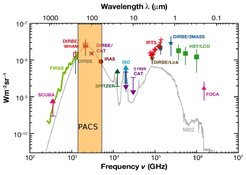
We have resolved about 35, 75, and 75% of the CIB due to galaxies at 70, 100, and 160 microns into individual three-sigma-detected sources for the blank field surveys, and have obtained number counts to unprecedented depth at these wavelengths. Lensing cluster observations and a fluctuation analysis increase these fractions further. Using the wealth of multiwavelength data already existing in the chosen fields, roughly half of the CIB at these wavelengths originates at redshifts below and above one, respectively, the dividing redshift increasing with wavelength.
Related publications include: Berta et al. 2010, Altieri et al. 2010, Berta et al. 2011, Magnelli et al. 2013.
How Does the Star Formation Rate Density and Galaxy Luminosity Function Evolve?
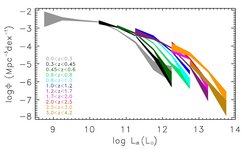
Our surveys sample the critical far-infrared peak of star-forming galaxy SEDs and probe a large part of the infrared luminosity function, down to luminosities of ~ 1011 L☉ at redshift 1 and < 1012 L☉ at redshift 2.
We have obtained detailed studies of the evolution of the infrared luminosity function with redshift, expanding on the results based on mid-infrared or submillimeter surveys and suppressing the associated uncertainties due to extrapolation of the IR SEDs.
The multiwavelength coverage of our fields ensures a robust estimate of photometric stellar masses, hence extending studies of the evolution of the specific star formation rate and the location of the star-forming "main sequence" to the previously missing obscured component of star formation.
Related publications include: Gruppioni et al. 2010, Rodighiero et al. 2010, Gruppioni et al. 2013, Magnelli et al. 2013.
What Is the Role of AGN and How Do They Coevolve with Galaxies?
The close relation in the local universe between black hole mass and spheroid properties calls for studies of how AGN and galaxies co-evolve. Feedback by AGN may also be central to terminating and keeping suppressed star formation in massive galaxies. Both locally and at high redshift, many infrared galaxies host star formation and an active nucleus.
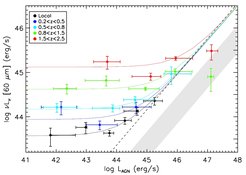
The PEP survey has shed new light on this relation, as a function of redshift and of galaxy properties, by studying for significant AGN samples the rest frame far-infrared emission and its relation to the AGN properties. The connection between AGN luminosity and star formation rate expected in some (merger) scenarios is observed only at high AGN luminosities and redshifts below one, but not for lower AGN luminosities and for all AGN luminosities at z > 1. This suggests a prominent role of secular evolution, in which the AGN luminosity and global host star formation do not strongly couple. AGN hosts on average form more stars than a mass-matched inactive galaxy. This is due to a larger fraction of "normal" main-sequence star-forming hosts, not due to few extreme starbursts.
Related publications include: Shao et al. 2010, Santini et al. 2012, Rosario et al. 2012, Rosario et al. 2013, Delvecchio et al. 2015.
What are the Infrared Emission and Total Energetics of Known Galaxy Populations? What Is the Role of Extinction?
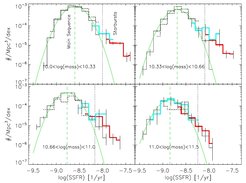
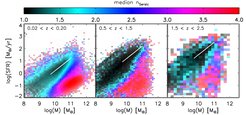
The detailed SED information now obtainable for infrared selected galaxies and the possibility to characterize galaxies out to z ~ 2 over the full SFR/stellar mass plane from a combination of Herschel, mid-infrared, and optical/NIR data have led to a clear revision of the local picture of galaxy properties as a function of IR luminosity. This requires a correction of previous SFR estimates that were based on applying local SED families to 24 micron surveys. Instead, a redshift-independent picture emerges when properties are expressed in relation to the evolving "main sequence" of star formation, consistent with increasing evidence about the gas richness of high-z galaxies. Out to z ~ 2, objects near the main sequence contribute ~ 98% of the star-forming objects and 90% of the star formation rate, have typically disk-like morphologies, and have infrared SED shapes similar to local normal galaxies, even if (at z ~ 2) total SFRs are similar to local merger ULIRGs. Merger morphologies and SEDs resembling local ULIRGs are found for the rare outliers that are placed well above this main sequence.
PEP now also provides the essential far-infrared complement for the characterization of populations selected at other wavelengths, such as SMGs, LBGs, and Lyman alpha emitters.
Related publications include: Elbaz et al. 2010, Nordon et al 2010, Hwang et al. 2010, Wuyts et al. 2011ab, Rodighiero et al. 2011, Nordon et al 2012, Magnelli et al. 2012, Berta et al. 2013a, Magnelli et al. 2014.
What Is the Relation of Far-Infrared Emission and Environment at Intermediate Redshift? What are the Clustering Properties of Infrared Galaxies?
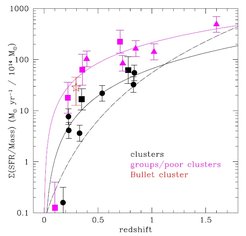
The far-infrared emission is a calorimeter of star formation for many types of galaxies. Hence, a large far-infrared survey is a unique method to determine in which environments most of the cosmic star formation occurred.
In the local universe, luminous infrared galaxies mostly avoid the dense cluster environments in which star formation has already declined. Optical studies and observed overdensities of submm sources around massive high-redshift objects already indicate that this must change dramatically at high redshift, toward a strong clustering of infrared sources in dense regions. We have mapped out the evolving clustering and environmental effects over redshift out to z ~ 2.
Related publications include: Popesso et al. 2011, Magliocchetti et al. 2011, Popesso et al. 2012.
What Is the Dust and Gas Content of High-Redshift Galaxies?
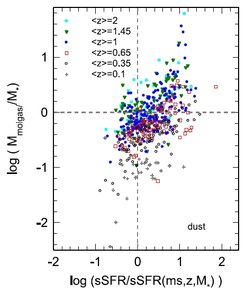
Dust masses of high-redshift galaxies or galaxy stacks can be derived from Herschel SEDs. Gas masses can then be estimated using metallicity-dependent gas-to-dust ratios. A comparison of such dust-based estimates with CO-based estimates of gas content provides important cross-checks of the methods used to measure the gas content of high-redshift galaxies.
From our Herschel data, we obtain scalings of gas content and gas depletion times with galaxy mass, specific star formation rate, and redshifts out to z ~ 2, all of which is in good agreement with CO-based estimates.
Related publications include: Magnelli 2012b, Berta et al. 2013b, Santini et al. 2014, Genzel et al. 2015, Berta et al. 2016.






